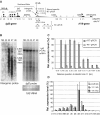Long-range chromatin interactions at the mouse Igf2/H19 locus reveal a novel paternally expressed long non-coding RNA
- PMID: 21478171
- PMCID: PMC3152352
- DOI: 10.1093/nar/gkr209
Long-range chromatin interactions at the mouse Igf2/H19 locus reveal a novel paternally expressed long non-coding RNA
Abstract
Parental genomic imprinting at the Igf2/H19 locus is controlled by a methylation-sensitive CTCF insulator that prevents the access of downstream enhancers to the Igf2 gene on the maternal chromosome. However, on the paternal chromosome, it remains unclear whether long-range interactions with the enhancers are restricted to the Igf2 promoters or whether they encompass the entire gene body. Here, using the quantitative chromosome conformation capture assay, we show that, in the mouse liver, the endodermal enhancers have low contact frequencies with the Igf2 promoters but display, on the paternal chromosome, strong interactions with the intragenic differentially methylated regions 1 and 2. Interestingly, we found that enhancers also interact with a so-far poorly characterized intergenic region of the locus that produces a novel imprinted long non-coding transcript that we named the paternally expressed Igf2/H19 intergenic transcript (PIHit) RNA. PIHit is expressed exclusively from the paternal chromosome, contains a novel discrete differentially methylated region in a highly conserved sequence and, surprisingly, does not require an intact ICR/H19 gene region for its imprinting. Altogether, our data reveal a novel imprinted domain in the Igf2/H19 locus and lead us to propose a model for chromatin folding of this locus on the paternal chromosome.
Figures








References
-
- Gabory A, Ripoche MA, Le Digarcher A, Watrin F, Ziyyat A, Forné T, Jammes H, Ainscough JF, Surani MA, Journot L, et al. H19 acts as a trans regulator of the imprinted gene network controlling growth in mice. Development. 2009;136:3413–3421. - PubMed
-
- Varrault A, Gueydan C, Delalbre A, Bellmann A, Houssami S, Aknin C, Severac D, Chotard L, Kahli M, Le Digarcher A, et al. Zac1 regulates an imprinted gene network critically involved in the control of embryonic growth. Dev. Cell. 2006;11:711–722. - PubMed
-
- Szabo P, Tang SH, Rentsendorj A, Pfeifer GP, Mann JR. Maternal-specific footprints at putative CTCF sites in the H19 imprinting control region give evidence for insulator function. Curr. Biol. 2000;10:607–610. - PubMed
-
- Bell AC, Felsenfeld G. Methylation of a CTCF-dependent boundary controls imprinted expression of the Igf2 gene. Nature. 2000;405:482–485. - PubMed
-
- Hark AT, Schoenherr CJ, Katz DJ, Ingram RS, Levorse JM, Tilghman SM. CTCF mediates methylation-sensitive enhancer-blocking activity at the H19/Igf2 locus. Nature. 2000;405:486–489. - PubMed
Publication types
MeSH terms
Substances
LinkOut - more resources
Full Text Sources
Miscellaneous

